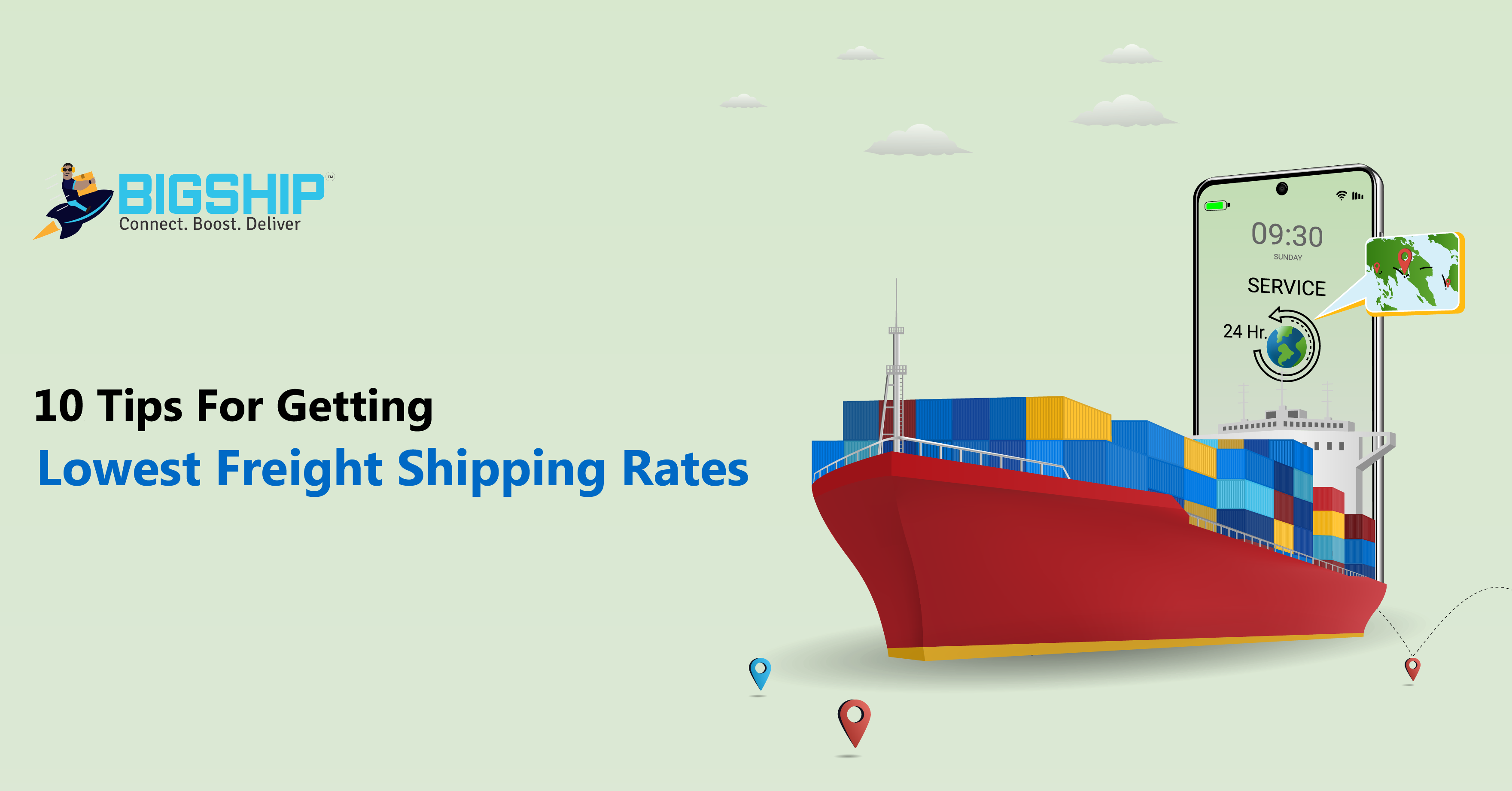How To Get Lowest Freight Shipping Rates

Contents:
2. Types of Freight Shipments
3. 10 Tips for Getting Best Freight Shipping Rates
4. Conclusion
5. FAQs
90% of global trade relies on freight shipping, making cost-effective shipping freight rates more crucial than ever. For businesses, managing freight charges effectively can mean the difference between profit and loss. Finding the best freight rates ensures operational efficiency and cost savings as it allows businesses to stay competitive.
In this comprehensive guide, we will explore the fundamentals of freight shipping and freight shipping rates, providing you with valuable insights and practical tips. From consolidating shipments to optimizing pallet space, and choosing the right carrier to explore alternative transport modes, there is a diverse range of strategies tailored to help you minimize freight shipping charges. Whether you’re a seasoned logistics professional or new to the world of shipping, these tips are designed to empower you in your quest for the best freight rates.
What is meant by Freight Shipping and Freight Shipping Rates?
Freight shipping refers to the transportation of heavy commodities and goods through land, sea, or air. It includes various modes, such as truckload, less than truckload (LTL), and intermodal transport, through trucks, trains, ships, and planes.
Freight shipping rates are the costs associated with these services, influenced by factors such as transportation mode, distance, weight, and volume. Effective management of freight rates is essential for businesses to ensure cost efficiency and competitive advantage. Understanding and optimizing freight shipping rates can significantly impact a company’s overall freight charges and operational expenses.
Types of Freight Shipments
Majorly there are 3 types of freight shipments and those are: full truckload, less than truckload, and partial truckload.
Full Truckload (FTL): In FTL, the entire truck will be filled with only one shipment. The truck is completely reserved for carrying only one shipment. The truck will not be picking up or dropping off any other order in the journey and this is why it will reach sooner to the destination. Full truckload requires less care because the chances of damage are less in FTL.
Less than Truckload (LTL): In LTL, numerous shipments are also loaded in a single truck that has multiple destinations. The truck will pick up and drop off each shipment along the journey. This way there is a chance of a shipment being delayed. LTL needs more careful handling as all the shipments are placed together so the chances of damage are high here.
Partial Truckload (PTL): PTL falls under Full Truck Load and Less Than Truckload, it is a mid-sized shipment where two or more shippers share the load and pay for their respective space. It is an affordable and cost-effective option for freight shipping.
10 Tips for Getting Best Freight Shipping Rates
If you are looking to cut freight shipping costs, here are some sure-shot tips that can help you manage these rates. These tips will help you secure the best rates and they are mentioned below.
Consolidate Your Shipments: If you regularly ship to and from the same location, consider consolidating your shipments into larger, less frequent loads. For instance, stacking and wrapping 50 similar-sized boxes onto a single pallet instead of shipping them individually saves money and time. You’ll pay less for freight and only need to track one shipment.
Choose the Best Carrier for Your Route: Go for the right carrier for your specific route. Smaller regional carriers might be more cost-effective for short-distance shipments, while larger national carriers are better for long, cross-country hauls. Carrier costs vary based on their hubs and routes, so selecting the right one can save you money.
Identify Your Freight Classification: Freight classification, set by the National Motor Freight Classification (NMFC), standardizes pricing based on an item’s transportability, including factors like density and handling. Classes range from 50 to 500, with higher classes costing more. Knowing your item’s class can help manage shipping costs.
Reduce Vacant Pallet Space: To save money, reduce empty space on your pallet. Pack it densely to keep the freight class low and avoid oversized fees. Keep pallet height under 60 inches to prevent additional surcharges.
Work with Third-Party Logistics Services: Managing shipments can be complex, so consider partnering with a 3PL such as Bigship. They handle various logistics tasks like packing, inventory management, and shipping. They also use AI technology to find the best rates and compare carriers, making logistics more efficient and cost-effective.
Explore Alternative Transport Modes: Depending on your shipping requirements, alternative transport methods like air freight, sea freight, or rail can be more cost-effective than traditional shipping. Collaborate with your 3PL provider to evaluate different options and determine the best transport mode for your shipments.
Consider Drop-off Locations: Be mindful of drop-off locations, as some areas have lower freight rates. Negotiate higher rates when shipping to these low-paying areas to cover return costs. Additionally, avoid frequent hauls to low-paying regions, as it can be financially risky.
Evaluate Load-to-Truck Ratio: Monitor the number of trucks available in your area. If there are many loads but fewer trucks, you can negotiate higher rates. Conversely, if there are more trucks than loads, rates may drop. Stay aware of local market conditions to optimize your negotiations.
Assess Your Shipping Agreements: Consistently evaluate and improve your shipping contracts with carriers to secure the most favorable freight charges and conditions. Collaborate with your freight forwarder to pinpoint areas needing enhancement and to bargain for improved terms with carriers.
Inquire About Additional Charges: Certain routes may incur higher costs compared to others, especially on longer distances. Conduct thorough research on potential additional fees or special permits required along the route. Ensure clarity on whether fuel surcharges are included in the rate offered. It is always wise to inquire about fees, freight charges, and surcharges to determine if they can be incorporated into the offered rate.
Conclusion
Businesses focused on staying competitive and profitable must prioritize securing the lowest freight shipping rates. By following the strategies outlined in this guide, such as consolidating shipments and optimizing pallet space, you can reduce freight costs while improving efficiency.
Understanding freight classifications, evaluating contracts, and staying informed about market conditions are also important. Remember to keep assessing and improving your shipping practices and consider alternative transport options. By incorporating these tips into your logistics plan, you can confidently manage freight shipping charges and save money for your business in the long run.
Sign up with Bigship to get the best freight shipping rates.
Tips to Get Lowest Freight Shipping Rates: FAQs
Ques: What factors determine freight charges?
Ans: Freight shipping rates are influenced by weight, freight classification, distance traveled, and additional fees. These factors collectively determine the cost of transporting goods, ensuring that rates align with the specifics of each shipment.
Ques: What is the cheapest way to transport freight?
Ans: The cheapest way to transport freight depends on various factors such as distance, weight, urgency, and type of goods. Generally, shipping by sea or rail tends to be more cost-effective for large, non-urgent shipments. Utilizing less-than-truckload (LTL) services can be economical for smaller shipments.
Ques: How to get the best freight shipping rates?
Ans: You can get the best shipping rates by following these tips:
- Consolidate shipments
- Choose the right carrier
- Understand freight classifications
- Optimize pallet space
- Consider alternative transport modes
Ques: What is a reasonable freight shipping rate?
Ans: A reasonable shipping rate depends on factors like distance, weight, and urgency of the shipment to be delivered.





